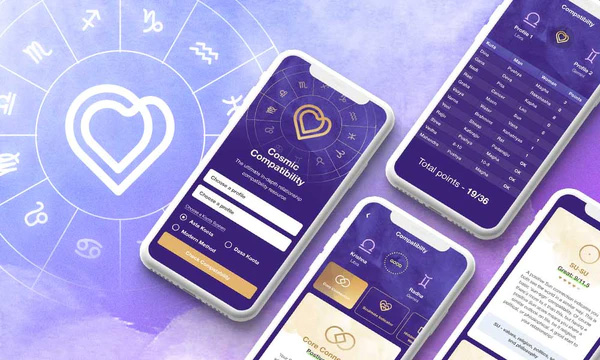In the world of Vedic astrology, the Ashtakuta system is a prominent method utilized to determine the compatibility between potential partners. It plays a vital role in assessing the nature, mental qualities, and other attributes which influence a relationship. Traditionally, it considers 8 primary Poruthams or compatibilities.

Get your Compatibility Report based on Ashta Kuta, Dasha Kuta and Modern Compatibility!
1. Dina (Nakshatra):
Dina Porutham is based on the Nakshatra (star) of the individuals. It calculates the compatibility based on the moon’s position in the bride and groom’s charts. A harmonious Dina Porutham indicates good health and prosperity in the marriage.
Access your Ashta Kuta compatibility on the Cosmic Insights App
2. Gana:
Gana Porutham categorizes individuals into three groups – Deva (Godly), Manushya (Human), and Rakshasa (Demon). It represents the inherent nature and temperament of the individuals. A good match is considered to be between people of the same or compatible groups.
3. Nadi:
Nadi Porutham is a significant aspect which considers the pulse or nerve energy indicating the physiological and heredity factors. Couples with the same Nadi are generally avoided to prevent potential health issues in offspring.
4. Rashi:
Rashi Porutham considers the moon sign in both horoscopes. It is believed to influence the couple’s love, affection, and friendship with each other. A favorable match ensures a harmonious relationship.
5. Graha (Graha Maitri):
This assesses the compatibility between the moon’s lords in both horoscopes, reflecting the psychological disposition, mutual affection, and attraction between the couple.
Access your Ashta Kuta compatibility on the Cosmic Insights App
6. Vasya:
Vasya Porutham measures the power equation between the partners. It helps in determining who would be more dominant and controlling in the relationship, aiming to ensure mutual attraction and love.
7. Varna:
Varna Porutham evaluates the couple based on four castes – Brahmin, Kshatriya, Vaishya, and Shudra. A match is generally considered good if the groom is of equal or higher Varna than the bride.
8. Yoni:
Yoni Porutham represents sexual compatibility and physical attraction between the partners. It classifies individuals into 14 Yoni types based on the Nakshatra and indicates the level of comfort and satisfaction in the marriage.
Access your Ashta Kuta compatibility on the Cosmic Insights App
Additional Poruthams:
9. Rajju:
Rajju Porutham is significant for the longevity of the marriage. It categorizes individuals based on the Nakshatras into 5 types: Paada, Ooru, Nabhi, Kanta, and Sirasu.
10. Stree:
Stree Porutham considers the potential financial prosperity and wealth of the couple. It is assessed by evaluating the position of the wealth-giving planets in the bride’s horoscope.
11. Vedha:
Vedha Porutham is concerned with the potentially obstructive stars in both the horoscopes. A match is considered unfavorable if the stars create Vedha or obstruction.
12. Mahendra:
Mahendra Porutham is believed to influence the progeny and longevity of the marriage. It denotes the strong bond and affection between the couple throughout their life.
Understanding and analyzing these Poruthams can offer insights into the various dimensions of a relationship. It is an intricate part of matrimonial matchmaking that seeks to ensure a harmonious and prosperous married life.


😲😲
I was so sad when I saw the negative result between me and a girl. I just didn’t know her birth time so I thought: “If I test the compatibility with all the lagnas, maybe the result will be positive.” After making all the combinations, the result continued to be negative. Dissatisfied with the result, yesterday, I was thinking: “Why should the result be negative if the girl herself was interested in me?” After thinking about this a lot, I think I had an epiphany, because it came to my mind what would happen if I change the Ayanamsa Lahiri using the great master number 11? I made the change using 11:11:11, when finished, I did the test between the two of us and oddly enough the result was very good. So I thought, “Should this number be defined to determine ayanamsa?” I just know I’m going to use this one now. Furthermore, even my Atma Karaka has changed even when using the 8 karaka system. My AK in Lahiri is Rahu, but after the change to 11, it became Guru. The AK Guru suits me a lot more…. It’s possible this was all coincidence.